Quick Links to Info in this post
How to create your personal coastal interior style
Let what you love most about being by the sea be your navigational compass.
In general you’ll want to choose a color palette of beachy hues, some natural textures and add decor accents that reflect your connection to the coast.
Light neutrals combined with hints of primary undertone colors such as yellow, red, and blue will create warmth.
Mixing patterns and textures gives your space dimension.
Lightweight linen and cotton fabrics lend a casual, cool feel. If you love coastal patterns or motifs, you might choose a comfy chair covered in a favorite design, like seashells or blue and white cabana stripes.
White is THE color in coastal design because it makes every space appear more open. Using it in your furnishings, walls, trim work, and soft goods (pillows, bedding, towels) gives a room its airy vibe. White proves to be the perfect backdrop to blues, greens, corals, turquoise, grays — all colors of coastal design.
Incorporate organic nautical materials such as rope, rattan, sisal, jute and driftwood. You’ll easily find tons of DIY ideas to repurpose items you already have into something new to complement your design.
Despite all these choices and decisions, the finished room usually has minimal decor. A coastal inspired home is designed for comfort through the use of color and textures.
Although coastal interior design at its core has the same basic tone, you can tweak the design to reflect your particular coastal style.
Coastal Farmhouse or Rustic Coastal Style – Where Farmhouse meets Coastal Cottage
Nantucket Coastal Style – Traditional, classic, comfortable and timeless
Coastal Chic Style – Urban or Boho personality takes to the seashore
Whimsical Coastal Style – Eclectic and quirky go beachside
Nautical Style – The feel of being at sea. . .without a boat
Beach Cottage Style – A smaller, cuter, casual bungalow
Tropical Island/Key West Style – Bright and fun colors of Key West and Bahama vacations
Mediterranean Coastal Style – European formality in a seaside setting
Coastal White Style – Monochromatic made casual with textures
Shabby Chic Coastal Style – Reclaimed elements and yard sale finds get a feminine twist
No coastal style is etched in sand! It’s just that some styles lean more one way than other.
Coastal Farmhouse gets it’s influence from reclaimed or distressed woods, for example, but this also holds true for Shabby Chic Coastal. So don’t let these restrict your choices. Use them as a starting place to hone your personal preferences.
Not sure which coastal style defines YOUR style? Check out the details in our post 10 Popular Coastal Design Styles.
Conquer your decorating fears
So in your attempts to get the coastal look you love, maybe you had a few low tide moments. Fear not. Welcome to the club!
The GOOD NEWS:You don’t need to be a professional interior designer to get the beachy style you crave.
For years I let myself become overwhelmed with too many choices: colors, patterns, textures, furniture and failed DIY projects by the dozens.
When decorating my first apartment, if I liked a rug or curtain in the store I took it home. The landlord had painted the walls a seafoam green. That should have been a great first step to creating a beachy style, right?
So why did I buy a Colonial wing chair with a floral pattern of reds and oranges? It matched nothing. But it was comfortable.
I’m looking at it now. Covered with a white blanket. Waiting to be made beach pretty with a slipcover. Why did I keep it, you ask? Because, you know, it’s still comfortable.
Repeating the same poor design choices…Over the years I’ve purchased or repurposed furniture or accent pieces for no rhyme or reason other than I liked it, all by itself.
I ended up with a mish-mash of something with the makings of a decorated house. No where near the glossy magazine pictures of stunning beach house designs.
Apparently growing up on an island, surrounded by sand and water offered me no decorating advantage!
But I had a mess of sea shells!
Clearly, I struggled at this decorating thing.
Decorating can feel like trying to put together a 10,000 piece jigsaw puzzle.
You know…the pretty picture on the box sucks you in. Then you see all the little pieces and get overwhelmed. Sometimes the puzzle sits on the dining room table for weeks waiting for you. Every now and again you find a few pieces that fit but you’re still not satisfied. Then you can’t find a corner piece and throw it all back in the box.
Thanks to years collecting magazine clippings, decorating books, hours binge-watching DIY and HGTV, and years of trial and error, I eventually found confidence with design basics.
Don’t let past mistakes or decorating phobia stop you.
Interior design is like putting together a good outfit.
You already know how to dress up a simple black dress. You build upon the basic style, layer by layer, with shoes, jewelry, etc. When you’re finished you look quite ravishing!
It’s the same way with interior design. Let’s go…
Each of the 10 layers of coastal style basics build on each other. Let them help guide your interior design choices to create the beach home decor of your dreams.

A coat of paint is an important layer of any room design, but not necessarily the first.
It’s the easiest and cheapest way to transform any space. Look at your wall color as the big canvas that will tie all the other elements in the room together.
DESIGN TIP: Because paint can always be color matched to just about any color you want, it’s a good idea to consider selecting a color that goes with furnishings and fixed elements. Replacing flooring or upscale furniture is of course pricier than even the most premium paints.
WALL COLOR PAINT
The perfect color for your room sets the mood for the rest of the decor. For a coastal inspired room choose paint colors that reflect the seashore, beach and sky.
Blue and Green (and all shades in between) = Water
Beige, Coral, Gray, White, Brown = Sand, Beachcombing finds, Organic Material
Shades of Blue, Yellow, Orange, Red and even Purple = Sky (from sunrise to sunset)
Paint can also hide or disguise wall imperfections, or highlight features, like crown molding or a fireplace mantel. Add rustic coastal charm by painting worn dark paneling a light coastal color.
There’s a reason why white is the most popular color in coastal decor. It evokes light and airiness to any space. But don’t settle for a completely bright white throughout or your risk having a room that feels cold and sterile. There are more white shades than you can count. Choose varying shades in creams, tans, grays, beiges.
Confused about paint colors? Read our post 5 Easy Steps to Choosing Coastal Paint Colors like a Pro. You’ll learn how to choose the perfect beach palette for one room or your entire home. Hint: One of the tips is to start with an inspiration piece.
I used this method to choose our living room paint color which led to a Master Bedroom Makeover using Sherwin-Williams Tradewind paint color. Up until then I never met a blue I liked. The blue paint wasn’t the problem. It was me! Choosing a color that looked great on a paint chip in the store but ugly on the walls at home.
Don’t forget about the 5th wall in your room — the ceiling.
If you choose a more bold wall color and opt for a white ceiling just be aware that your room will feel closed in. A bold wall color (a totally great idea) will benefit from a ceiling color that complements the walls. Use a color wheel to find complementary colors or tint the ceiling paint with a TINY bit of wall paint.
WALLPAPER
Not your grandma’s floral wallpaper. Today’s wallpaper choices are bold and totally a beach worthy interior option.
A beautiful texture like linen gives a bathroom an organic and casually elegant feel, while a navigational flags motif adds a pop of whimsy to a kid’s bedroom. Try stripes, patterns or buffalo checks in beachy colors for a coastal twist on a classic design.
Need inspiration for a bedroom makeover? You’ll like this: MASTER BEDROOM MAKEOVERS WITH SHERWIN-WILLIAMS TRADEWIND
Feeling a bit color phobic? You’ll like this: 5 EASY STEPS: HOW TO PICK COASTAL COLORS

Architectural details and embellishments add value to homes, but also a ton of charm and character.
ARCHITECTURAL DETAILS
Your home may be blessed with the good genes of exposed beams, cathedral ceilings, built-in book shelves, wood fireplace mantels or tall high ceilings surrounded in crown molding.
If not, there are easy ways to add them or to create the illusion of a must-have look.
INSTALL FAUX BEAMS
Real beams are great but if your room or budget doesn’t allow, consider faux beams. They are lightweight and durable and look more realistic than ever. They are a perfect weekend DIY project.
ADD MOLDINGS AND TRIMS
Ceiling moldings and door trims are another DIY project that make the bland and boring, interesting and notable.
DUMPSTER DIVE!
I’ve been known to pull over on the side of the road to search for “stuff”. On the way to my dentist’s office there’s a house renovation in the works. Since I had multiple appointments (ugh) the small dumpster has caught my attention each time. Lots of great salvage wood that I’ll use to make signage!
You can be less bold about trespassing than me.
Scour flea markets, garage sales and salvage yards for reclaimed interior doors and corbels. Find an old wooden shutter and lean it up against a wall or flank an opening or archway with a pair.
Ask friends and neighbors to search their cast-offs. You’ll never know what’s hiding in a basement, attic or storage bin if you don’t peek. These finds can truly become a one-of-a-kind statement piece.
UPDATE EXISTING WOOD ELEMENTS
A wood fireplace mantel that has been stained or painted can be sanded down and restained or repainted. Choose a high gloss white for a more Traditional style or paint a flat white and distress a bit with sandpaper to give it a Rustic Coastal or Cottage look.
It’s easy to paint natural wood white — floors, trim, moldings, doors, archways, wall paneling. A whitewashed stain will add an airy coastal appeal to your design.
Optionally, you may like the look naturally unfinished architectural elements. Rub mineral oil on raw wood to bring out the grain.
Or lightly stain raw wood to create a warmer feel versus pure white or whitewashing.
Whatever you choose, be as consistent as possible throughout the room or entire house.

Flooring is considered a background color so choose a color that will go along with the other layers you’ll be adding. Plus, unlike paint, it’s an expensive do-over. Pick a flooring solution you can comfortably live with for a while.
FLOORING
Installed hardwood, tile, stone, linoleum or wall-to-wall carpeting are all good flooring options for a coastal home.
Adding area rugs not only define space but add texture and dimension to the room. Natural open-weave natural fibers like sisal, seagrass and jute evoke a beachy vibe.
They’re also durable, making them perfect for high-traffic areas, indoor-outdoor spaces, kids and pets. And can hide a multitude of flooring issues.
The added benefit is that throw rugs, runners and special shaped ones are easily (and more cheaply) replaced if and when you need a change of color or style.
By choosing a coastal motif, stripes, big bold or colorful designs, an area rug adds personality afoot that is both versatile and portable!
Use area rugs to anchor larger furniture pieces, welcome guests or create a fun addition to a kid’s space.
WORK WITH WHAT YOU HAVE
If you can’t change out the floors to what you’d love, work with what you have.
I was stuck with, read that: HATED, the Terracotta octagonal tile in our small entryway. Originally, like 20 years before, the grout was white but had stained in spots over time. It was ugly and my eye naturally went there every day entering the house. Replacing it was not an option.
Because we were getting ready to sell the house I regrouted the tile with a thin layer of black grout.
Then I chose a very pale gray wall color. Lastly, I installed white wood slat blinds that matched the trim work in the two cottage windows that flanked the front door.
It looked adorable. And the floor was no longer an eyesore.
Design Tip: Accentuate what you can change to suit your style. Let what you can’t change fade as best you can.
A hardwood floor with damaged finish but are otherwise in good shape are easily sanded and stained.
There’s hope for messed up floors too.
My Dad had a small art studio in our attic growing up. He painted the wide floorboards a bright turquoise color. One, because he had leftover paint from another project, and two, because it covered years of his creative life’s spills and stains.

Coastal furniture should look like it will stand up to salty air and sandy feet even if you live hundreds of miles from the sea.
UPHOLSTERED FURNITURE
This layer, high ticket over-sized fabric covered furniture, is essential for seating and lounging. Included here are couches, love seats, recliners, chairs, ottomans, perhaps a headboard.
You might want to keep the larger pieces neutral in color. That doesn’t mean everything should be beige! Think about texture here and durability of the fabric as well as the color.
For smaller upholstered items, like dining chairs, ottomans or an accent chair, have fun by selecting a colorful fabric, trim or coastal inspired design.
Comfortable seating is a come on in, relax, southern coastal welcome. Pass the sweet tea.
Design Tip: Consider each purchase carefully. I like to be able to move pieces to other rooms to mix it up a bit when I get bored. Which is often! Also, if there’s a chance you’ll change homes in the near future, a well selected piece just might find a happy place in your new location.
SLIPCOVERS, SLIPCOVERS, SLIPCOVERS
Many furniture styles are available with custom slipcovers, perfect for the casual coastal living. Family, pet and day-at-the-beach friendly they can be thrown in the washing machine or dry cleaned.
There are endless fabric selections to choose from. And the skirting on slipcovers also lends a laid-back, yet sophisticated touch.
I’m all about using what you have too.
We have a couch and loveseat that this family adores for it’s width and deep seating comfort. Trouble is that between dogs and kids the fabric is trash.
I found a DIY video from Lisa at Farmhouse on Boone (thank you Lisa!) on how to make slipcovers using painter’s drop cloths.
Honestly, it tested my seventh grade sewing skills to finish slipcovers for the couch and loveseat. In the end I was so pleased — it totally changed the look of the room too, for less than $100.
There were a few takeaways from my attempt at bleaching the drop cloths that I’ll share at another time.
Briefly, in my quest to get the cloths really white I over-bleached them. This, I believe, ruined the integrity of the fabric. It’s thinner and less durable than it should be.
My dog is now banished to another chair. Don’t do that. Drop cloths will never be truly white. And dog paws will never be totally clean or dull.
Here are the before and after images of the loveseat.
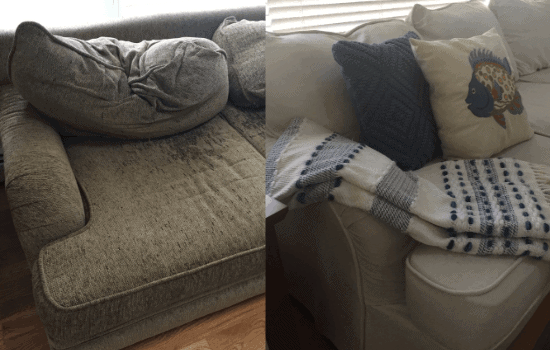 Slipcovers can transform loved but well worn upholstered furniture. This DIY project tested my 7th grade sewing skills! Saved $$ and complements the coastal decor.
Slipcovers can transform loved but well worn upholstered furniture. This DIY project tested my 7th grade sewing skills! Saved $$ and complements the coastal decor.If all these decorating layers so far sound “plain” and “boring” hang on. Color, texture and more will be added in the following layers to visually add coastal punch to your design.
Upholstered furniture is an investment. I’m strongly encouraging you to select solid and textured fabrics rather than prints, which are the first thing to date a room.
Fun prints and coastal motif seasonal pillows and throw blankets are easily changeable. It will cost you much less to replace a set of flamingo toss pillows when you grow tired of them instead of reupholstering the flamingo and palm tree covered couch.

Fabrics used in coastal interior design should be unassuming and anchor-your-feet-here friendly. Essential coastal patterns and organic fabrics will be your best bud as you customize the look and feel of your home.
FABRICS
Indoor/Outdoor fabrics are perfect options for slipcovers and pillows. They clean up easy and are fairly resistant to whatever cocktail you spill on them!
Adding a printed, embroidered or embellished fabric is what will give your style it’s personality.
The key here is to make sure the fabric pattern is balanced evenly throughout the space. You want your eye to move around the room and not be overwhelmed by too many colors and patterns.
Mix and match patterns with a light hand. Think a lovely plated meal versus a stir fry made of refrigerator leftovers.
Got it?
In each room it’s a good idea to use the same or closely complementary fabrics in drapes and a few toss pillows. This will keep everything cohesive and make the room feel calm and anchored.
My master bedroom has white floor length curtains in a woven pattern, for added texture. Frankly, they’re more decorative than functional.
And the guest bathroom has a white on white seashell embossed topper. The window and floor trim is white. It keeps the tiny space light and airy.
I’ve scored some oh-so-cute but not-too-garish sea life motif toss pillows that are scattered around the house. I move them from time to time, and because the color scheme in all the rooms complement each other, they live happily from bedroom to living room to the front hall bench. Ditto for some accent pieces. I’m learning!
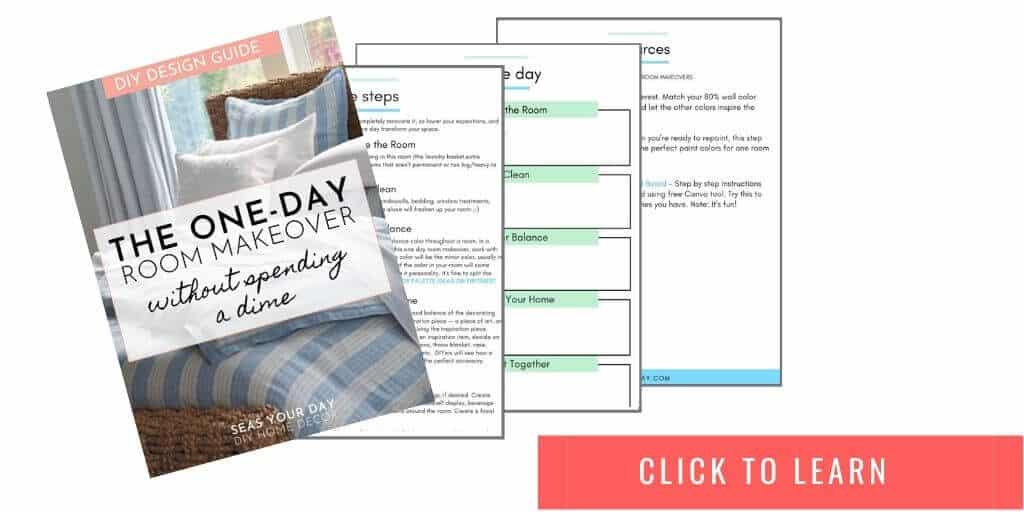
STRIPES
Of course when we think coastal design, stripes come to mind. These take on many forms:
Navy Breton stripe is reminiscent of old sailing days.
Traditional wide cabana stripes are a comfortable choice for nautical and coastal chic designs.
Other bold patterns that aren’t exactly stripes but have geometric lines include: CHEVRON, HERRINGBONE, BASKETWEAVE, GREEK KEY. Keep these styles in the color palette you choose and they will blend nicely while lending a unexpected twist.
SEA LIFE INSPIRED MOTIFS
Theme and sea-life inspired motifs — seashells, whales, anchors, mermaids, corals, flamingos, boats, palm trees, etc. — become the life of the party friend who makes everyone happy!
NAUTICAL SYMBOLS AND ICONS
Symbols and icons such as anchors, ropes, life rafts, flags and compasses are go-to designs for the nautical style.
COASTAL MODERN
For a modern twist, choose patterns not often identified with coastal style. Like using stripes, keep the colors of polka dot, floral or check patterns in a coastal color palette.
To find the right balance of patterns for your personal look start with a minimalist approach. One or two motifs in a room. Try a white cotton couch pillow embroidered with a navy blue whale paired with nubby navy solid or polka dot cotton pillow with fringe.
ORGANIC FABRICS
When it comes to fabrics go natural with linen and cotton textiles to create a light, easy, beachy feel. Linen is naturally resistant to bacteria, so it will play nice when subjected to wet bathing suits and sandy feet.
You’ll like this: Nautical Decor & Design Ideas for Modern Coastal Living

A home infused with light feels more open and airy and breathable. In the absence of natural light, you have lots of options…
LIGHTING
The reason white is such a great coastal design color choice is the way natural light bounces off the surface to create the illusion of brightness.
NATURAL LIGHT
Natural light plays a central role in coastal design. Big windows, skylights, specialty windows like bay, bow, round and more also give a coastal home its charm.
Adding or replacing windows that will bring in much needed sunlight is one option.
Another less invasive, and cost effective way to bring in more daylight, is to remove heavy drapery, blinds and shades.
With the exception of the guest bathroom and master bedroom, all the windows in our house (30 or so) are naked. We did install white wood slat blinds on the street facing windows to shut at night. But mostly we leave them open to allow the sunshine, and moonlight, stream in.
In two of the bedrooms we opted to keep the woven rattan shades that came with the house. They lend an organic beachy feel to the spaces. Honestly, I’ve never let them down so they act more as a topper.
ARTIFICIAL LIGHT
Today, light bulb choices can add different “white” light depending on the mood you want to set. Options range from early morning light to moonlight, and a range of cool colors, if you want to add fun to your next party!
To add more light to your home look up to the ceiling first. Consider these lighting choices:
- Canned or recessed lights
- Chandeliers
- Pendants
- Wall sconces
- Track lights
Place tables lamps on surface areas like counters, accent furniture like bureaus, desks and side tables. Use other lighting such as flameless candles, lanterns, and luminarias to add shadow and reflection in the evening.
With basic coastal design in mind, look for lighting that is embellished with sea influences such as twine, brass, wicker, glass, coral and seashells. Choose lighting that matches your particular coastal style.
A cottage style with a hanging chandelier made with seashells or wicker add both a sweet style and casual comfort. A nautical style is enhanced with brass or rope enhancements. You get the idea.

You need places to hold your beach gear, books and beachcombing finds. And flat surfaces to put your feet, snacks and Margaritas on!
ACCENT AND MISCELLANEOUS PIECES
Coffee tables, consoles, side tables, and bookcases, shelves, chests and accent chairs add functionality to any space.
For this layer you’ll want to be sure there is ample surface area for what you need, within an arm’s length of its purpose.
Accent furniture placement is key because you don’t want to be stretching and lunging like an Olympic gymnast to reach a drink.
Add a pop of personality — paint a reclaimed or unfinished furniture piece, like a coffee table or side table, in a glossy bright green, blue or coral.
Wicker and rattan furnishings fall under this layer. Nothing says tropical vacation like a wicker settee or rattan rocking chair.
SHELVES, WALL UNITS AND BOOKCASES
This layer is the donkey of miscellaneous furnishings! They don’t get a lot of respect for the load they carry.
We have a wood island cart with open shelves that I store my daily dishes and serving bowls. It saves me from reaching high into the cabinets, open and closing doors. It sounds lazy, I know, but having the open shelves at mealtime is super functional.
If you’re lucky enough to have built-in bookcases (score for Architectural element!) or a stand alone unit, use the open shelving to display accessories as well as books, statement elements such as navigational compass, clocks, barware and beach treasures.
DESIGN TIP: To make stand alone wall units look like built-ins, try painting them the same color as your trim.
ACCENT TABLES
Have an antique chest do double duty as an end table or coffee table as well as storage. Metal, wood and rope trimmed tables are all good choices for a coastal home. If Nautical is your coastal design favorite check out these NAUTICAL STYLE ACCENT TABLES.
Be sure that side tables are big enough to hold a lamp, decor items and your morning coffee. Puny little tables actually make a room look small and cluttered.
BASKETS AND TOTES
Wicker, rattan and canvas baskets become depositories for storing everything from sandy flip flops to garden tools to throw blankets. Baskets make great under bed storage too.
You’ll like this: SEAGRASS BASKETS, BINS AND TOTES
ICONIC ELEMENTS
This may sound a bit out there, but nothing embodies the feel of seaside more than the classic Adirondack chair. With its natural recline backrest and deep seat this accent piece is the epitome of summertime relaxation. Either the durable wood version or polywood kind will weather a very long life of abuse.
These chairs work well alone or as a side by side pair, outdoors of course, but also indoors. Great for a sunroom or three season porch. A wonderful seating choice for a playroom. And with wide armrests for snacks and drinks, a seriously fun choice for that basement “Man Cave”.
Also, repurpose large rope spools into accent pieces. Painted or varnished these can be used as side tables or cut down at coffee table height. For a completely coastal feel wrap the base in thick roping, just like its original use.
A thick glass top turns the iconic lobster trap and fish crate (yep) into a coastal table to serve guests food and drink with a side of interest and whimsy.

This layer is all about accessorizing your home with items that hold meaning to you. If there’s every a time to throw caution to the wind and express yourself, this is the place to show off and have fun.
ARTWORK, MIRRORS, OBJET D’ART
It’s time to dig through all the pieces you’ve been hoarding…uhm, collecting.
Think about the types of wall art you love to be surrounded with and start playing with placement around your room or house.
This includes mirrors, which are great light reflectors and space stretchers.
A large beautiful oil painting, wall hanging or art object will anchor a room.
Grouping similar style or themed paintings, prints or photographs evokes memories of an afternoon stroll through an art gallery.
Painted wood signs are all the rage (love them!) and they’re also an easy DIY project. Customize a reclaimed board with your favorite quote, beach name or coastal motif symbols.
My version of DIY Hand Painted Wood Beach Signs are simple to make and don’t require fancy tools or artsy skills.
The only rule for using a statement piece in a room is that YOU love it.
Take your favorite eye-catching item and put it on display. Restrain yourself from using too many pieces to avoid overwhelming the space. A large item like a salvaged ship’s wheel can be completely captivating.
A friend bought an authentic maidenhead at auction and installed near the top of a vaulted ceiling. Talk about a statement! (P.S. I’ve seen these made of paper mache at flea markets…someday I’ll try to make one.)
She also incorporated a salvaged brass ship’s porthole as the window in her guest bathroom. Ahoy!
The key to adding accessories is to live by this rule: Less is more. The art of good accessory display is about editing.
Accessorizing is a bit of a dance. Approach it as a fluid process and you’ll find what makes you happy and where to put it. Move things around, tweak the displays you create.
You’ll want to mix newer pieces with older items too. These can be family heirlooms, pieces collected from your travels as well as your personally made artwork. This is the fun part. Have fun!
Be aware of too much matchy-matchy as it comes off as sterile and cold. For example, say that coral is your favorite color. That’s great. Use the color in various items and textures and you’ll be fine. If coral is used in 20 ceramic pieces scattered the same room, the room can lose its warmth and cham. Group them together to achieve a wow factor.
By using a bit of restraint with accessories you give the space a chance to breathe. The last thing you want is a room to look like an all-you-can-eat seafood joint. You get that, right?

Plants literally add oxygen to the air so their use in your decorating is worth considering. No green thumb? No worries. The faux plants manufactured today are realistic and beautiful, not to mention maintenance free.
Live and Artificial Plants
Plants help to blur the space between indoors and outdoors leaving you to listen for birdsongs and rolling waves.
Many varieties such as Jade, Spider and Peace plants require very little maintenance. I call them the low drama guests. Always welcome in my home.
Small trees, like Ficus, Parlor Palm and Yucca, also do well indoors. A canned up-light placed below a small tree provides beautiful soft shadows on the walls and ceiling at night.
I keep a hibiscus plant outdoors during the summer and take it in once the New England air changes. This baby is 15 years old! It’s quite happy, blooming all winter in a sunny window with little care other than a thorough weekly watering.
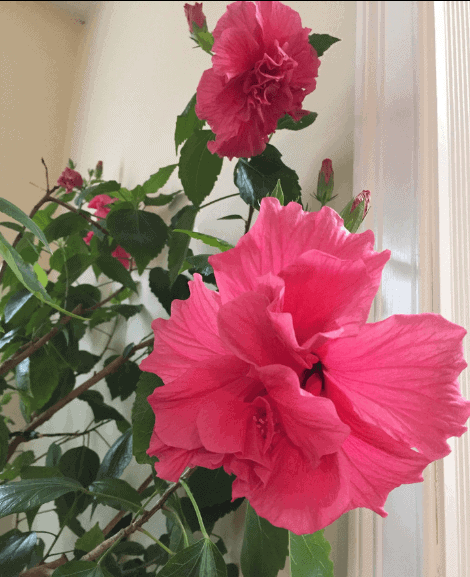
With little maintenance this pink hibiscus plant moves from outside to inside and blooms all year.
Nix the live variety for faux ones if it fits your lifestyle better. A silk palm tree or over-sized banana tree adds a tropical island atmosphere even in the dead of winter.
Give them a wipe with damp cloth a few times a year. In nicer weather bring them outdoors and spray the dust away with a garden hose.
Real or not, having plants as part of your coastal decor suggests nature and life and fresh air.

Here’s where all your childlike beachcombing skills come into play. Gather shells, sea glass, driftwood and other collected sea treasures.
NATURAL ELEMENTS
The final layer of coastal style is decorating with the jewels of the sea. Conch Shells and Starfish are welcomed on open shelves, table tops, side tables, console tables.
A huge piece of driftwood displayed on the low shelf of a hall console table is striking and sculptural.
How many seashells have you collected? Thousands?
Be careful not to clutter the house with too many. Instead, create sweet vignettes on a side table or shelf. My friend picked an underused bathroom shelf to display beach finds near her Gulf Coast home. Lovely.
A simple and chic way to display shells, small pieces of driftwood and coral is in a clear glass vase. Pick a shape and size you love, fill the bottom with a few inches of play sand (or beach sand) and add your favorite seashells inside for a beach-inspired display. Place a chunky votive candle in the center to use as a light source for indoor or outdoor gatherings.
If you love collecting shells from your travels, create a pretty label with the name of the place or beach. These become instant personal keepsakes.
Beach glass is another lovely beachcomber treasure. Display in clear vases like shells or turn them into art objects, like wreaths, wind chimes, decorative plates or jewelry.
Step by step to create your beach house design
Coastal or beachfront living is a dream for most. There’s something about sandy beaches, crystal clear blue water and the smell of the salty ocean that makes us “feel” like we’ve found nirvana.
Whether you’re lucky enough to live a few flip-flop steps from the sea or miles away, use these 10 basic layers of coastal decorating to bring that day-by-the-sea feeling to your home, every day, wherever you live.
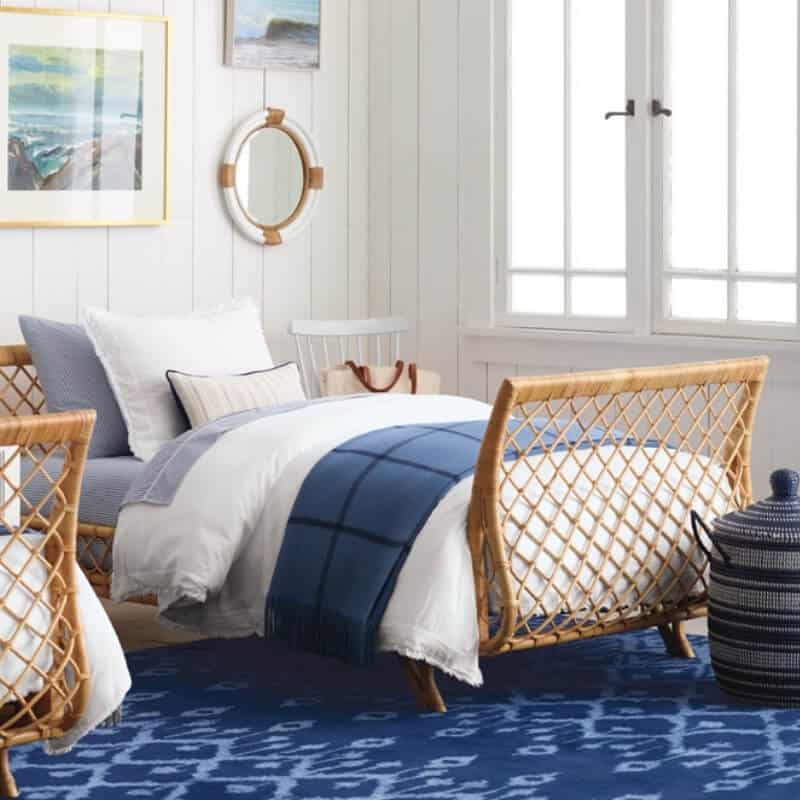
Posted: November 12, 2018
Nautical decor gets its modern polish from crisp white and blue furnishings to appeal to the seafarer in all of us. A few well-appointed wicker pieces, brass accessories and cabana stripes gives a could-be kitchy design its comfortable sophisticated look.
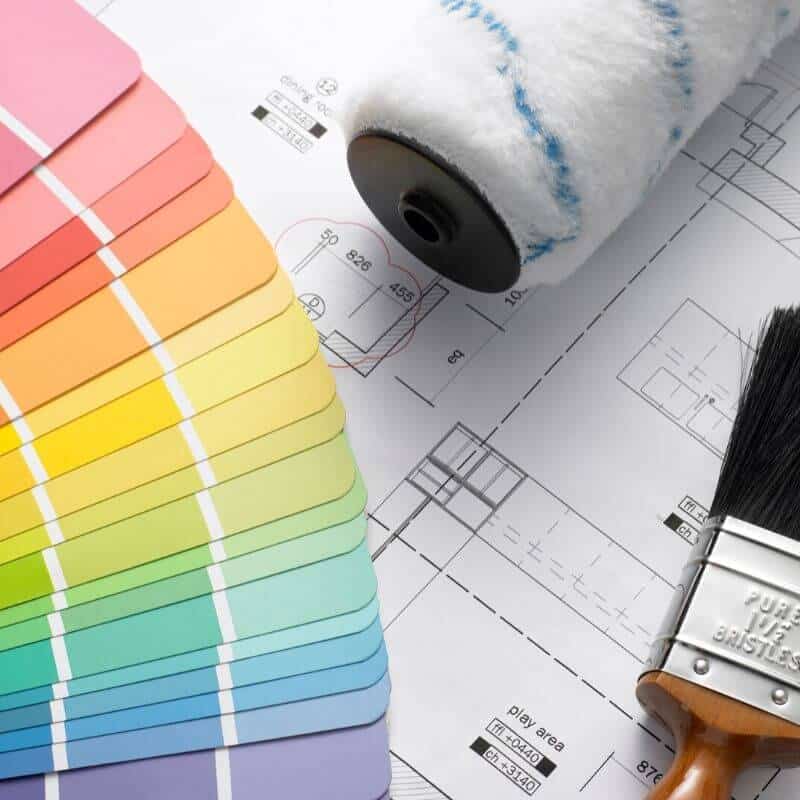
Posted: November 15, 2018
5 easy steps for perfect coastal paint colors for home interiors. Using inspiration pieces create the perfect beach palette for one room or entire home.
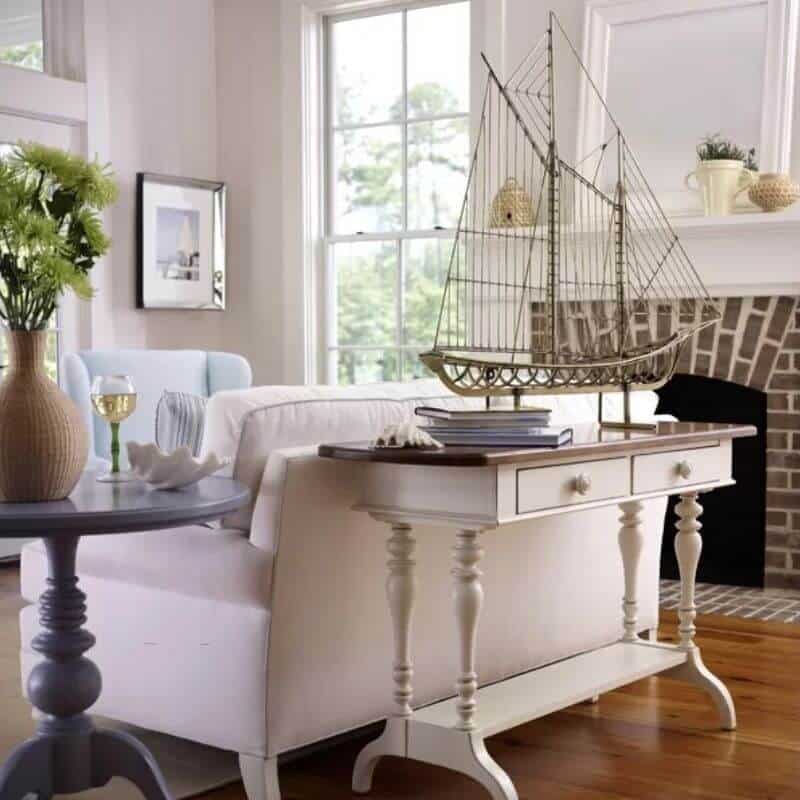
Posted: March 8, 2020
It’s the subtle nod to the sand, sea and sky that gives the popular coastal home decor its timeless appeal.

Posted: July 10, 2019
Paintings and Prints become the inspiration for choosing beach house paint colors. Favorite coastal wall art is the perfect muse when selecting paint colors to complement your beach house style decor.
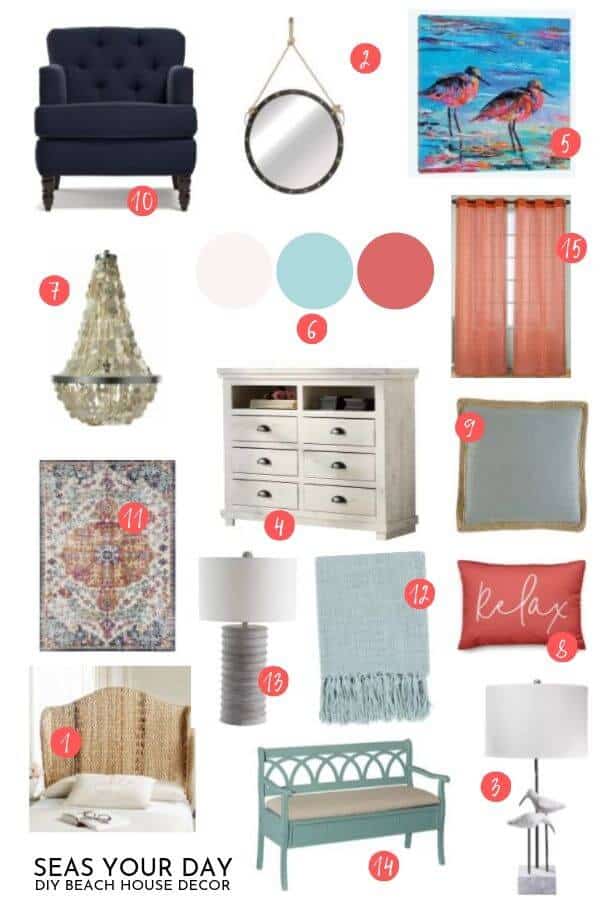
Posted: August 14, 2019
Step-by-step instructions to make a room design mood board using free Canva tool. It’s fun…and addicting! #inspiration boards #coastal farmhouse #canva

WANT TO REMEMBER THIS IDEA? Please PIN THIS POST to your favorite PINTEREST BOARD!
P.S. We want your browsing experience to be a great one. Find an error, missing or broken product link? Contact me here and I’ll fix it. Thank you!